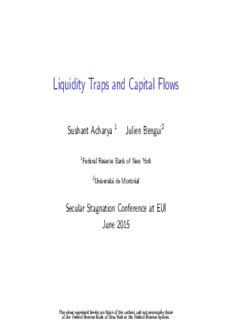
Liquidity Traps and Capital Flows PDF
Preview Liquidity Traps and Capital Flows
Liquidity Traps and Capital Flows Sushant Acharya 1 Julien Bengui2 1FederalReserveBankofNewYork 2Universit´edeMontr´eal Secular Stagnation Conference at EUI June 2015 Theviewsexpressedhereinarethoseoftheauthorsandnotnecessarilythose oftheFederalReserveBankofNewYorkortheFederalReserveSystem. motivation Loose monetary policy in advanced economies deficient demand period of binding zero lower bound (ZLB) on interest rate During early stage of liquidity trap, capital flows from advanced to emerging economies increased markedly appreciation of emerging mkt currencies some emerging mkts: imposed controls to limit currency appreciation Accusations of currency wars 2/36 motivation Loose monetary policy in advanced economies deficient demand period of binding zero lower bound (ZLB) on interest rate During early stage of liquidity trap, capital flows from advanced to emerging economies increased markedly appreciation of emerging mkt currencies some emerging mkts: imposed controls to limit currency appreciation Accusations of currency wars 2/36 motivation Loose monetary policy in advanced economies deficient demand period of binding zero lower bound (ZLB) on interest rate During early stage of liquidity trap, capital flows from advanced to emerging economies increased markedly appreciation of emerging mkt currencies some emerging mkts: imposed controls to limit currency appreciation Accusations of currency wars 2/36 risk of currency wars ... “The industrial economies are using ultra-loose monetary policy, while the emerging markets are using currency intervention and capital controls. (...) The tools they are using will create distortions – both ultra-loose monetary policy and intervention risk creating excess liquidity and asset price bubbles. If capital is too cheap, we will tend to use it too much. If the exchange rate is too low, we will focus on producing for exports. And if tempers boil over, we could get ugly protectionism.” - Raghuram Rajan (2010) 3/36 questions 1 What role do capital flows and exchange rates play during regional liquidity traps? 2 What are the multilateral implications of capital flow management in response to loose monetary policy? Can a regime of capital flow management raise welfare of all parties involved? Should countries not subject to a liquidity trap optimally manage inflows of capital? 4/36 questions 1 What role do capital flows and exchange rates play during regional liquidity traps? 2 What are the multilateral implications of capital flow management in response to loose monetary policy? Can a regime of capital flow management raise welfare of all parties involved? Should countries not subject to a liquidity trap optimally manage inflows of capital? 4/36 motivation Following Fleming (1962) and Mundell (1963): common perception that no role for capital account management with flexible exchange rates Recently Mundell-Fleming view has been challenged by policy makers: IMF revised stance, stated in Ostry et al. 2010, emerging market governments academics: argument based on financial frictions, nominal rigidities, terms-of-trade management 5/36 motivation Following Fleming (1962) and Mundell (1963): common perception that no role for capital account management with flexible exchange rates Recently Mundell-Fleming view has been challenged by policy makers: IMF revised stance, stated in Ostry et al. 2010, emerging market governments academics: argument based on financial frictions, nominal rigidities, terms-of-trade management 5/36 this paper Environment 1 micro-founded multi-country model with nominal rig. and flex exchng rates 2 region of world economy experiences a liquidity trap 3 monetary policy is set non-cooperatively by each country Key insights: In a liquidity trap... 1 non-coop. monetary policy by a country imposes AD externality on world economy 2 free capital flows are Pareto inefficient capitalflows“tooslowly” doesn’tinduceenoughdemandreallocation&expenditureswitching 3 welfare gains not achievable by non-cooperative capital flow management 6/36
Description: